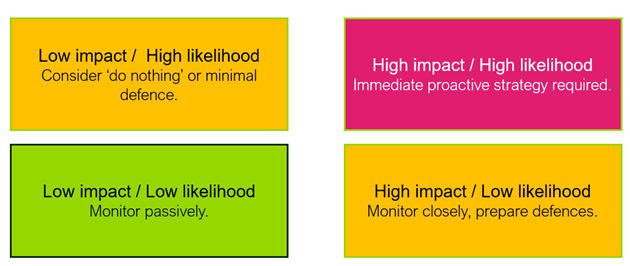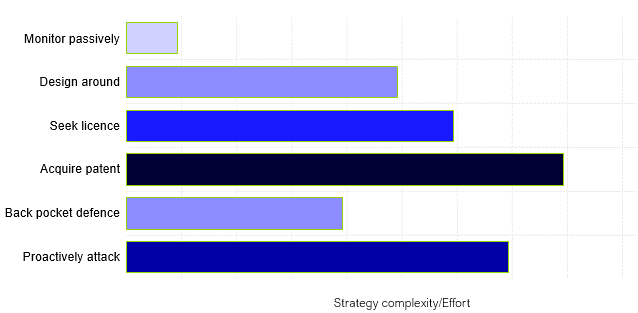On 1 July 2025, Emer Bollinghaus, Nick Shipp, and Alexander Korenberg discussed tactical responses to patent obstacles in the finale of our three-part series on IP risk analysis.
Key Takeaways
The discussion had three key messages.
Firstly, third-party patent infringement risks should be identified swiftly. Don't wait for a problem to arise; actively identify and evaluate potential patent infringement risks before they impact your business. It is crucial to classify these risks in terms of the potential likelihood of the third-party patent holder acting against you and the potential impact of that action on your business.
Secondly, choose the best mitigation strategy for the risks identified. The most effective mitigation solution is a tailored one that considers your specific situation.
Lastly, regularly monitor your strategy. The business and IP landscapes are constantly evolving, and your risk mitigation strategies need to do the same.
Understanding Third-Party Risk
Third-party patent infringement risk is a significant business threat. Unmanaged, it can lead to substantial financial losses, operational disruptions from injunctions, and reputational damage. It can also create market uncertainty and impede future business planning.
Assessing risk involves balancing the likelihood of the risk becoming a reality – for example, by the third-party patentee filing a lawsuit against you – with the potential impact that such a reality would have on your business. This balance can be split into four broad categories, each with a different respective mitigation approach, in an “Impact-Likelihood risk matrix”:

A “High Impact, High Likelihood” scenario, such as a strong patent being held by a litigious direct competitor, demands immediate and proactive action. Conversely, a less critical patent or one held by a less aggressive entity might warrant a less intensive response.
Gauging 'likelihood' requires analysing the patent holder’s current position and the projected impact of your actions on their business. The industry itself also influences risk; fast-moving sectors like software present different risk profiles than highly regulated ones like medical devices.
How to Manage Third-Party Risk
After categorising the risk, there are many risk mitigation strategies available, which have varying levels of complexity and resource commitment:

Passively monitoring a patent infringement risk situation is often suitable for instances of low potential impact and low likelihood of the third-party acting against you. It can be appropriate when a patent is weak, infringement is questionable, or likely commercial impact is minimal, and for pending patent applications. While monitoring an application, you might consider filing third-party observations or preparing for an EPO opposition if it grants. But the downside of passivity is that uncertainty remains, and you are not actively changing your risk profile.
When a patent is strong but narrowly defined, designing around the risk patent’s claims, to avoid infringement, is often effective. This requires close collaboration between legal and R&D teams. While it can involve R&D costs and potential delays, it sometimes unexpectedly leads to product improvements.
When the patented technology is essential to a product and a design around is not viable, seeking a licence to the risk patent may be a wise consideration. Engaging third-party experts for negotiations can maintain discretion and achieve better outcomes. Licensing can also provide access to cutting-edge technology and know-how, accelerating your company's own innovation.
Acquiring the risk patent can also eliminate the threat and allow you to leverage the patent for competitive advantage or new revenue. Opportunities for acquisition can arise, for example, when patents are not actively used or are held by financially distressed entities. Utilising a broker can facilitate anonymous transactions. The acquisition of a patent may expand to acquiring the entire company – which can have the benefit of you also acquiring its people, products, and market position.
For higher-stakes situations, more assertive legal strategies – or, at least the preparatory work for them –are worth considering. For example, it may be wise to perform the upfront legal work for a back pocket defence in case of a lawsuit. This avoids the immediate disruption of a lawsuit, but prepares you for swift action, should one come your way. A strong defence requires detailed analysis and investment of both time and financial resource. It can involve building a defensive patent portfolio (e.g., through divisional applications) and, for US patents, securing a US counsel opinion to mitigate treble damages. Additionally, filing a protective letter with a court (e.g., in Germany or the UPC) can preemptively reduce the risk of emergency injunctions by setting out your case in advance.
Sometimes, you may decide the only option is to proactively attack the risk patent, for example if there is a strong non-infringement or invalidity case or an unreasonable patent owner. This is usually a last resort option, as litigation is expensive and its outcome uncertain. In Europe, options include revocation actions in national courts or the UPC. An EPO opposition is a less costly route, with the potential for anonymity, but it must be filed within nine months after grant. Strategic monitoring of competitor applications should be carried out, to leverage this limited window of opportunity.
What Next?
Knowing what potential risks are out there in terms of third-party patents is vital, but is only part of the battle. It is imperative to understand how such risks can affect your business and how you can proactively monitor and mitigate them. As no single solution fits all, it is essential to implement a tailored and dynamic strategy.
At Kilburn & Strode, we have the knowledge and expertise to aid you with responding to patent obstacles in a way that meets your commercial needs and considers your entire business landscape. We have a wealth of experience in risk resolution that we can use to help you understand your potential risks, develop a bespoke plan to mitigate them, and put this plan into practice in the most effective way to safeguard your strategic interests. We always strive to understand your company’s needs so that we can create the most effective and customised solution to aid your commercial success.